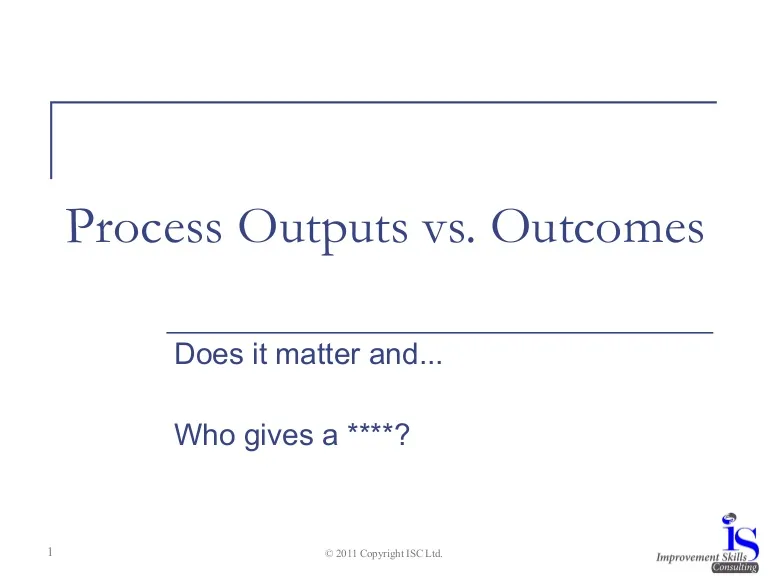
Description
Maybe I’m being pedantic, but if you don’t understand the difference between a process output and an outcome, how can you manage and continuously improve performance?
Transcript
Process Outputs vs. Outcomes Does it matter and... Who gives a ****? © 2011 Copyright ISC Ltd. It’s very clear to me...
- There is no process that produces Customer Satisfaction as an Output
- There are (many) processes that deliver Outputs that have an impact on whether, or not, Customers are satisfied
© 2011 Copyright ISC Ltd. What is a Process? A process is an activity, or series of activities, that converts an input, to an output, by doing work. Processes only exist to add value, achieve outcomes and meet the requirements of customers (and stakeholders) Purpose: Customer Outcome © 2011 Copyright ISC Ltd. INPUT OUTPUT PROCESS An example
Input Process Output © 2011 Copyright ISC Ltd. Dissatisfied Customer Satisfied Customer Resolve Complaints Have you got it? Input = Process Output = A Complaint An Apology, A Complaint Report Actually = An Outcome of a previous process Actually = An Outcome of a well- handled complaint © 2011 Copyright ISC Ltd. Dissatisfied Customer Satisfied Customer Resolve Complaints Basic Principles
- Outcomes are about “Desired Performance”
- Outcomes can therefore have “Measurements” associated with them (e.g. Corporate-level Indicators)
- Processes deliver “Outputs” (to “Customers”)
- The Quality, Timeliness and Quantity of Outputs contribute to Outcomes
- The Quality, Timeliness and Performance of Processes contribute to Outcomes
- There may be “one-to-many” or “many-to-one” relationships between Processes and Outcomes
© 2011 Copyright ISC Ltd. Processes, Outputs, Outcomes Customer & External Facing Processes Output Output Output Outcome Outcome Outcome Process Level (Measured by Process KPIs) Organisation Level (Measured by Corporate Headline Indicators) Customers receive outputs © 2011 Copyright ISC Ltd. Outcome Processes, Outputs, Outcomes Customer & External Facing Processes Widget Invoice Brochure RFT Widget On-time Invoice Correct Addressee Process Level (RFT, OTIFA etc.) Organisation Level (Customer Sat.) Customers receive outputs © 2011 Copyright ISC Ltd. Happy Customers Improvement Approach - Control - Impact - Influence - Resource © 2011 Copyright ISC Ltd. Define the Desired Outcome Define the Measurements associated with the Outcome Identify the Processes that contribute to those Outcomes Define the Process Outputs Identify the Process Owners Prioritise the Processes Improve the Processes Measure the Process & Outcome(s) Compare with the desired Outcome Assess “As Is” Process situation Organisation Outcomes: examples
- Crime Reduced & Community Safety Improved
- Employment & Prosperity for all (from a vibrant local economy)
- Lifelong Learning & Personal Development Promoted
- Health & Welfare Promoted
- Improved Access to Services
- Motivated/Satisfied Staff
- Profitable & Cash-positive
© 2011 Copyright ISC Ltd. Reasons why it matters
- Identify their key processes
- Know whether/how key processes contribute to achieving the Corporate Strategic Objectives (expressed as outcomes)
- Identify owners for each of the key processes
- Ensure clarity and ownership within the organisation in order to drive process and performance improvement
© 2011 Copyright ISC Ltd. © Copyright Improvement Skills Consulting Ltd. (September 2011) E: [email_address] M: 07850 728506 W: www.improvement-skills.co.uk T: @ianjseath © 2011 Copyright ISC Ltd.
